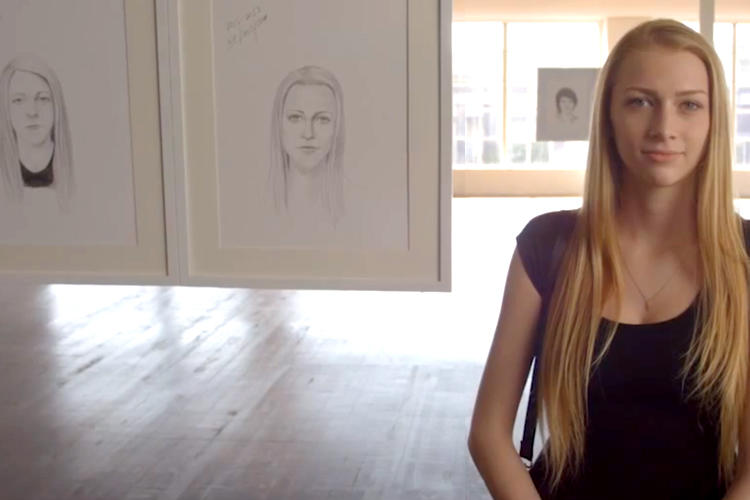Unless your Facebook friends are completely preoccupied right now with Gabrielle Giffords’ Op-Ed and Science Bros, you’ve seen multiple teary re-posts of Dove’s newest “Real Beauty” video this week, in which a forensic sketch artist draws portraits of “real women” without ever seeing them. The artist asks each woman to describe herself, and they all oblige with damning self-criticism like “I kind of have a fat, rounder face” and “I’d say I have a pretty big forehead.” Take-away: Women are our own worst critics!
Except we’re not — at least, not naturally. All of that body image baggage is internalized by growing up in a society that enforces rigid beauty standards, and since the target demographic for this ad is clearly women over 35 with access to library cards (which is to say, women who have had some time to figure this reality out), it is baffling that Dove can continue to garner raves for its pandering, soft-focus fake empowerment ads.
The only interesting thing Dove has done since it began this campaign to sell soap in 2004 is overtly shift the emphasis from sexual attraction to peer approval. The real take-away is still that women should care whether a stranger thinks she is beautiful. That’s not radical — it’s the thesis of every beauty product ad campaign ever.
The “Real Beauty” campaign is almost a parody of itself at this point — the emo string quartet, the wise, vaguely sinister “expert,” the soft lighting that’s straight out of a Real Simple photo shoot. You half expect Fred Armisen to show up in a wig eating yogurt. The ironic twist comes when the women reveal that the producers also asked each woman to “get friendly with this other woman” before they were sketched. Then the artist asks each woman to describe her new buddy’s face (“She was thin so you could see her cheekbones” — score!).
When he reveals both sketches to each woman, everyone has feelings, because Sketches A, based on self-description, look like outtakes from the Napoleon Dynamite Book of Cryptozoology. Sketches B, of course, look like actual human beings.
Because the artist is a former police sketch artist, as in the guy on “Law & Order: SVU” who makes the drawing Tutuola brandishes at cowering neighbors during a canvass, who really cares if portrait B has a thinner nose and brighter eyes than portrait A? They both look like suspects in a burglary gone wrong. And yet women across the globe weep into their feeds and repost, doing Dove’s dirty work for it in the name of self-empowerment.
Time magazine calls it a “short documentary,” but it’s just another commercial for all of the products parent company Unilever sells under the Dove umbrella, like deodorant and soap. It’s not exactly a commercial for the products Unilever sells under different brands, like diet chocolate shake in a can Slim-Fast and Rejuveness anti-wrinkle cream, because buying those products suggests you’re not ready to claim your role as a “real woman” who was lucky enough to be born with a relatively pleasing face that you will only really see when it’s reflected back to you by some dude who used to work for the cops and a lady you just met in the green room.
“I should be more grateful of my natural beauty,” a lovely blonde in her 40s admits with a studied, humble grace. “It impacts the choices and the friends that we make, the jobs we apply for, how we treat our children, it impacts everything.”
“Do you think you’re more beautiful than you say?” asks the sketch artist, who is not, according to his on-screen credits, a licensed therapist.
“Yeah,” she affirms, albeit weakly. Because that’s the right answer. It’s never OK for a woman to admit that she knows she’s kind of average-looking and she’s OK with that. In the radical world of Dove, nothing matters more than being perceived as beautiful — not being a kind and generous friend, not being a smart and talented professional, not even being decent to kids.
Stop me if you’ve heard this before.
Here’s another experiment. Find a 4-year-old and ask her to draw a picture of you. At the same time, blindfold yourself and draw a self-portrait. You might be surprised to learn that through a child’s innocent eyes, you’re actually a potato with a shock of purple hair, sticks for limbs and a triangular nose that rests somewhere south of where you always imagined your neck to be. You no longer have a neck — didn’t you used to have a neck? — but your arms have never looked thinner! And that triangle nose is so much more dainty than the Cubist mountain perched on the bulbous pumpkin you blindly drew for your own head.
Is that what you see in the mirror every morning, an eye mounted grotesquely atop your left ear? What kind of monster do you think you are?
Imagine, instead, seeing yourself through the eyes of a preschooler with a developmentally appropriate understanding of perspective and anatomy. Every drawing she makes of every woman looks pretty uniform — same potato head and torso, same stick arms — because we’re all the same, aren’t we? Except you get a scrawl of purple hair, because she thinks you’re a princess and also she can’t find her brown crayon. That’s how she sees you. How do you see yourself?

